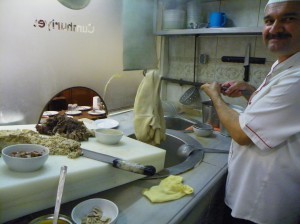Lisa Niver's Blog: We Said Go Travel, page 389
May 12, 2014
Cape Town, South Africa: When Fight Means Flight
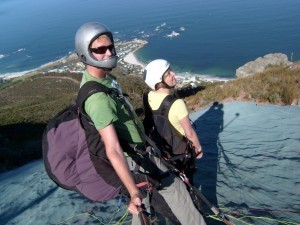 After many years of travel, my first trip to Cape Town brought the rush of excitement that experienced travellers don’t often get. I went there on business and fell in love with the city, the beautiful beaches, the view of Table Mountain out of the office window and… outdoor adventures. I used to be the kind of person who prefers opera, nice hotels and long brunches to outdoor activities. Adventure for me was to fly to see a new country.
After many years of travel, my first trip to Cape Town brought the rush of excitement that experienced travellers don’t often get. I went there on business and fell in love with the city, the beautiful beaches, the view of Table Mountain out of the office window and… outdoor adventures. I used to be the kind of person who prefers opera, nice hotels and long brunches to outdoor activities. Adventure for me was to fly to see a new country.
Cape Town made my heart stop like no other place ever would. Standing on the trail, looking at the cliffs of the Cape of Good Hope and the ocean stretching beneath them felt like being at the end of the earth. Breathtaking views, the feeling of the wind on your face, thoughts about how timeless this is and how travellers must have felt hundreds of years ago watching the ships battle at sea. You can’t capture this on pictures. It will always be part of my memories. I suddenly understood what timeless meant. There may not be another time for us to experience this but the place of eternal beauty will remain for others to enjoy and be inspired by.
That year at an event in the office we used a simple warmer at each of the tables before getting into the main exercise of the strategy rollout: “What’s your name, where were you born, what’s your favorite place to vacation?” The answer to the last question almost every time was Cape Town! I was beginning to understand why. I decided to give it a try and get out of my comfortable shell but do it at my slow pace. Luckily I had an opportunity to return to my new place of inspiration a few times to get new experiences.
I started out with sandboarding. It’s like snowboarding but on sand dunes. It has turned out to be very tame and fun even in the heat of summer, which, of course, is winter where I lived. No skills were required, just willingness to try, fall a lot, get up and go again. Quadbiking was the next adventure in store. Driving around the tracks with fantastic desert scenery, chasing after a group of German adventurer-tourists I have just met, was a real thrill. I had to go to the next level. Stepping off 1,000 meter above the sea level top of Table Mountain to abseil was when I understood what adrenaline really meant. Now, I am not afraid of heights, but that 112 meters descent, vertical drop that is, despite the encouragement from the adventure company team screaming “Yes, you can!” was really beyond my limits. Having come down alive, to my huge surprise, I acquired a huge amount of strength and made it back to the top as fast as if I had been training to sprint uphill all my life.
What else was left to try? I have watched paragliders landing on the beach with envy many times. What better place to go for it than Cape Town? I was fully committed to do it and signed up for a tandem flight when even a better idea surfaced. What if I could convince two other women, my friends from work to do it with me? This is going to be a bonding experience of a lifetime. My friends are local to Cape Town but their taste of adventure was more like mine before the first sandboarding run. I didn’t fully expect them to commit but they did. So one early Saturday morning we drove up to Lion’s Head mountain and met up with our tandem partners. As we hiked up to the takeoff site, the fear was growing with every step. All of us seriously considered thanking the pros and running back as fast as we could. Fight or flight was the only thing I could concentrate on. I am going to freeze instead of run. Natural body response, don’t you agree? And that’s when my tandem partner and I would crash and die. No, worse, we get hurt. Badly. We were the first to take off. I could not hear anything around me, just blood pumping in my head as we ran together in what seemed to be a slow motion. The next thing I knew we were gliding through the air and everything around us was so peaceful and colorful. My friends landed shortly after me, each conquering their own fears during the flights. I won’t get a paragliding certification but am really proud of choosing to fly!
About the Author: Yelena Parker is a serial expat and founder of Moving Without Shaking Ltd, expat and executive coaching consultancy. She blogs about expat life and success.
Thank you for reading and commenting. Please enter our next Travel Writing competition and tell your story.
The post Cape Town, South Africa: When Fight Means Flight appeared first on We Said Go Travel.
May 11, 2014
Zambia: Dance with Me
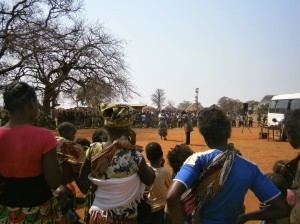 All around me I see the red dust of the Zambian earth. I look down and see that my feet are completely covered in it- this is nothing new, the dust here gets into everything and after two months in the village I am used to my feet being permanently caked in red. Sitting on the ground between the water hole and the big baobab tree, there is a crowd of people around me.
All around me I see the red dust of the Zambian earth. I look down and see that my feet are completely covered in it- this is nothing new, the dust here gets into everything and after two months in the village I am used to my feet being permanently caked in red. Sitting on the ground between the water hole and the big baobab tree, there is a crowd of people around me.
Today is a big day for the village and nearly everyone had gathered in what I call the village square. Today the military is sending a team of people to the village to talk to the community about corruption and voting rights. A few months ago an election for a seat in parliament turned quite nasty, with candidates buying votes and rampant corruption.
In an effort to save face the President declared the election results void, and ordered them to be held again. His solution to decrease corruption, which I think is brilliant, is dancing policeman and soldiers. In my opinion this is pure genius, it will definitely score the president major points with the rural population as it provides them with one thing they are desperate for. Entertainment. Village life is really, really quiet. I think the biggest event of the week was when about 50 village kids watched me doing my laundry. So the imminent arrival of Zambia’s finest to dance and perform a show is hot entertainment and not to be missed. Will it help prevent corruption and vote buying? Probably not, but you never know.
A large crowed has gathered was waiting for the performers arrival. Women sit chatting, their colorful chitange cloths wrapped around their waists and heads. Toddlers and young kids meander through the crowd; one of them wanders up to me and decides to sit in my lap. The older girls are braiding intricate dreadlock hairstyles on each other, and younger boys are playing football nearby. There are few men; most of the boys will only arrive after the performers do, so for now the village square is a girl’s only zone. The performers were supposed to arrive an hour ago, so they arrive right on Africa time, trundling up to the crowed in a dusty little Japanese made van. I am amazed with Zambian car packing skills, as a generator, several speakers, a table and fifteen people unload out of the tiny van.
The first act opens dramatically with loud Congolese rap blaring out of the speakers and the dancing policemen taking center stage. They whirl, they shake it, and they even throw in some Njuanja (local warrior) dance moves. The crowd is loving it; the people are clapping and chanting and every village child gets up on stage to join them. After their wildly successful opening act one of the soldiers takes a microphone and starts making a speech, my neighbor tells me that he is telling the people that voting is their right, that it is their duty to vote for who they think is best, and most importantly that their vote is secret. If your headman tells you to vote for one person that is corruption, and corruption eats at the soul of Zambia. I have to agree, corruption poisons the heart of this county. I see it when the taxi driver has to pay a bribe to the policeman to get past a roadblock, and when western mining companies strip the land bare of its natural resources without a penny to its people. In many ways Zambia’s political fortitude is amazing. They have endured civil wars raging on every border, floods of refugees, one of the highest AIDS rates in the world, low national income, and yet they have never had a civil war or dictator. And to tackle corruption, a problem that has brought other countries to chaos and conflict, their solution is dancing. In my mind, as a curly haired toddler sits in my lap watching the show, Zambia is doing OK.
About the Author, Kristi Young: Since graduating from university I have spent my time traveling and seeing the world. Mostly I have been working with refugees in the Middle East, though I greatly enjoyed my time in Africa. Traveling has been my passion for years, ever since my first overseas trip when I was 11. I am planning on traveling for another year or two before starting law school.
Thank you for reading and commenting. Please enter our next Travel Writing competition and tell your story.
The post Zambia: Dance with Me appeared first on We Said Go Travel.
The Peace of Green: Slovenia
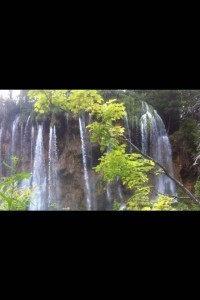 What is an inspirational place to me? I can think of only one. It takes me to emotional places that I’m never at. It makes me feel unique and special. This place makes me feel confident like I have wings and I can fly anywhere. In this particular place, I am optimistic because it motivates me to do things I wouldn’t dare to do normally. It helps me conquer my biggest fears. This place helped me conquer my fear of heights. The bravery and determination I felt could only be found in this place. Slovenia.
What is an inspirational place to me? I can think of only one. It takes me to emotional places that I’m never at. It makes me feel unique and special. This place makes me feel confident like I have wings and I can fly anywhere. In this particular place, I am optimistic because it motivates me to do things I wouldn’t dare to do normally. It helps me conquer my biggest fears. This place helped me conquer my fear of heights. The bravery and determination I felt could only be found in this place. Slovenia.
I visited Slovenia throughout the summer of 2013. Slovenia is beautiful from all perspectives. Its most distinct and touching beauties are the green mountains and the beautiful wildlife. There are such amazing forests, sparkling streams and breathtaking waterfalls. You don’t get to see such remarkable things anywhere else in the world. It has such outstanding and clean beaches, ponds and lakes. The rivers were amazing for canoeing and kayaking, taking me through marvelous waterfalls. The waters were crashing down on to rocks at a perfect tempo, which made listening to it so enjoyable. At times, it seemed like the waters were just as excited and full of life as I was to be there.
The extreme sports I participated in were especially significant. I never expected to be able to do extreme sports of any kind however, towards the end I realized that they all inspired me from so many perspectives. At first, I was nervous and scared. There were many rope obstacles at least 20m high. Being afraid of heights, I was only able to attempt these due to the clean open air as well as all the beautiful mountains and forests I was able to see from up there. I was hanging by a rope in midair, but it felt like flying or like I was an astronaut floating in space. There, 20m in the air, I was safe physically and emotionally, although I expected to feel the opposite.
At some point I reached almost 100m above ground which expanded my view greatly. The higher I got, the more astonishingly beautiful the view got. I could see so deep into the mountains that I forgot I was even in the air. The wind was blowing which made the trees dance so marvelously. This all made the mood perfect and evoked such motivation within me to go on with my participation in the extreme sports.
The most crucial activity for me was bungee jumping. I was almost 100m above ground and I was supposed to jump in into nothing, held only by a rope. Preparing to jump, I looked out at the beautiful view of the Slovenian Alps and was swept into a daydream. All I could hear was the wind blowing strongly. There were no cars, no city lights and no noise pollution. I was just surrounded by enormous mountains. It was beautiful. I was oblivious of my family and friends who were standing on the ground screaming up to me and supporting me, all well aware of my fear of heights. In that moment, at peace with the beauteous view in front of me, I felt confident about jumping. I didn’t need any support. I just stood there, breathing in the incredibly fresh, clean air.
The time to jump was coming. I looked down at the ground; then I made a wise decision not to do that again. Oddly, despite the height, I felt safer than ever. It was so bizarre that I felt no fear; I just knew that I could do this. Still relishing in my inner peace, I looked up at the sky and jumped. Flying through the air, my mind cleared and I had no thoughts. Thinking could happen later, on the ground. My eyes were closed most of the time and I remember the profound silence as I free-fell. As I let go and jumped from such a height, I also let go of my fear of heights. It felt so good!
My family and friends said they were cheering for me while they looked on from below. I didn’t even think I deserved any cheering. In my perspective, that was only a small accomplishment, aided by the beautiful mountains and the clean fresh air. I overcame my acrophobia, but I didn’t deserve any special cheering. It was Slovenia that deserved all the credit. I had taken a great step in my life and because of it, I now have the confidence to do other things I would have never done before. The Slovenian Alps gave me an inner peace I will always have and still inspire me to continue taking great steps in my life.
Douaa Satel
About the Author: Douaa is 14 years old, from Israel. She is a freshman in high school. She has been writing since she was very young. Douaa enjoys traveling, playing the guitar, writing and baking.
Thank you for reading and commenting. Please enter our next Travel Writing competition and tell your story.
The post The Peace of Green: Slovenia appeared first on We Said Go Travel.
The Magic of Mindful Moments in Mexico
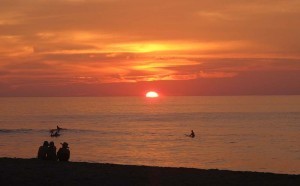 It’s a land I get lost in, emerging fuzzy headed, unsure where the time has gone. One, two, six hours can pass, clicking from one screen to the next, getting sucked ever deeper into a maze of trivia, gossip and stories I can’t say no to. It’s an addiction – something I know doesn’t feel good, but I continue on with nonetheless.
It’s a land I get lost in, emerging fuzzy headed, unsure where the time has gone. One, two, six hours can pass, clicking from one screen to the next, getting sucked ever deeper into a maze of trivia, gossip and stories I can’t say no to. It’s an addiction – something I know doesn’t feel good, but I continue on with nonetheless.
Opportunity for digital detox presented itself in November 2012. After years of saying “not enough time” or “I’m not good enough”, I finally signed up to a yoga teacher training course in Mexico’s jungle beside the ocean.
Four weeks of aches and pains, small triumphs and a path towards more presence. I rose with the sun, shook my shoes for scorpions and made friends with the nighttime creatures – kaleidoscopic moths and preying mantises with tiny red tongues. The world revealed more each day – a new shade of green, the scent of new flowers in bloom. I had time and space to notice it all.
When time came to return to writing, my boyfriend and I decided we’d stay put. The local town had charmed us with the sound of waves, the sight of the jungle and a community we were welcomed into from first breath. We felt a part of something in San Pancho. We belonged.
I started to teach yoga in the local plaza in return for donations – fruit, massages, and chocolate – an economy of give and take. I did use the computer, but my relationship to it changed. I used it to write and to work. I no longer found myself lost.
Those six months in San Pancho were golden, shining with memories of dear friends, daily sunsets on the beach, and the certainty that we were exactly where we wanted to be. We could have stayed forever, we almost did – coming within an inch of buying land – but instinct caused us to pause.
We weren’t ready to put down roots. The call of the world still sounded and unanswered doubts lingered on. We didn’t need to rush, to “lock it down” or make it fixed. San Pancho had shown us we could feel at home in a world far from the place we were born. It was a planetary experience and not one that needed to be grasped at.
A year later, and the lessons of San Pancho live on. It taught me the importance of community, of support and friendship beyond the screen, and of the power of nature to refresh, revitalize and heal. It made me revel in the details – the sounds, the scents, the sights. As Eden Philpotts so beautifully said: “The universe is full of magical things waiting for our wits to grow sharper.”
My wits did grow sharper in Mexico and they have strengthened ever since. Old habits still fight on and time sometimes slips into mindless moments, but less so than the time before. This work is a process not a pill.
Time is teaching me that happiness comes from gratitude, noticing and appreciating each moment, and being mindful of how you live your life. Of course there will always be things we like less, but those moments are balanced by their necessity and the moments of things we love.
Those halcyon days in San Pancho were rich with happiness and mindful moments – time I knew was beautifully spent. When you taste that experience – that possibility and potential – the opposite becomes ever more acrid. I still sometimes get lost in my computer, I sometimes even choose to, but I always come back to the sweetness and the pursuit of being present. It’s a new addiction. It’s mindfulness.
About the Author: Victoria Watts is a writer, blogger and nomad from London. She lives to explore the world and the many paths (and cakes) within it. Read about her adventures on her blog Bridges and Balloons.
Thank you for reading and commenting. Please enter our next Travel Writing competition and tell your story.
The post The Magic of Mindful Moments in Mexico appeared first on We Said Go Travel.
May 10, 2014
Italy: Along the Appia
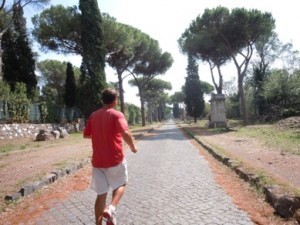 Around six a.m., Sol Invictus awakens to greet Rome’s citizenry, his soft sunlight illuminating two thousand years of a parabolic empire. I too rise, my well-worn running shoes resolving into focus as I touch the window to get a sense of the morning’s chill. Outside, my journey awaits.
Around six a.m., Sol Invictus awakens to greet Rome’s citizenry, his soft sunlight illuminating two thousand years of a parabolic empire. I too rise, my well-worn running shoes resolving into focus as I touch the window to get a sense of the morning’s chill. Outside, my journey awaits.
Stones the color of old dimes – four-inch mortared squares pieced together for four hundred miles – disappear into the distance on the Via Appia’s journey toward the sea. Atop the ancient boulevard, solitary wheat stalks emerge and sway beneath a Mediterranean breeze. Each year I come to run Rome’s road, taking time away from the hyper-trafficked Trevi Fountain and the falling-down Colosseum. Like those more famous monuments to antiquity, the Appia is crumbling, its roadside statues falling before modernity’s might, its stones absorbing the footfalls from centuries of centurions, citizens and tourists. But, before decay comes creation, and the Appia is heavy with engineering triumph.
The road is named after Appius Claudius Caecus, the Roman censor who completed the Via Appia’s first section as a military thoroughfare to the south in 312 B.C. Less than a century later, it traversed the entire Italian Peninsula. Over the millennia, Rome’s inhabitants have used its rough route to transport Caesars, slaves, food and weapons. Today, eroding effigies litter the roadside, their fissured faces betraying the history of a once-great Empire. Time, after all, ages all men.
The stones’ stability is menopausal and my arches ache with the unevenness. In the distance, an old Italian man whistles something vaguely operatic, and, on the rolling morning air, there is an almost ubiquitous garlic scent. Up ahead a nozzoni waits. Its unyielding cold water, pouring since the BC age of the great aqueducts, teems from the nozzle. My morning runs offer insight into life’s transience – the broken bricks, the sulking statues, a fallen empire. But too, they lead toward a horizon, where each step may bring one closer to fulfillment. I pause, satiating myself amidst the ancient water, resting in sweet spot of life between time’s relentlessness and anxiety about the future. It is like a baptism, a life-affirming renewal that comes from leaving the past’s decay behind.
The stone faces stare at me, whispering wise words -
With each step we construct a life, but all footprints fade.
Like the water you are drinking, like the road you are running, live your life.
Upon the Via Appia, one has no use for rear view mirrors.
A Puccinian whistle wakes me from my daydream. Ahead, the stones summon. There will always be more road, and then a sea, and then a horizon where possibilities await. And so I run, pursuing that hem in the sky, my eyes on the distant stones, Rome’s history crumbling before me. With every heel strike I am pounding out my autobiography. I can hear the prologue now:
Memories are not for the days when we should be creating them, but rather, for an age when we need them.
About the Author: CC Xander is a professional speaker and one of America’s elite tennis coaches. Should you wish to join him on meaningless literary excursions, explore CC’s blog.
Thank you for reading and commenting. Please enter our next Travel Writing competition and tell your story.
The post Italy: Along the Appia appeared first on We Said Go Travel.
Bhutan’s Seasons of Change
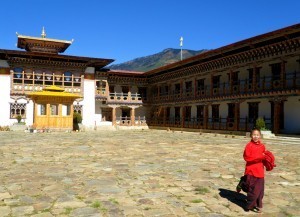 I arrived in the painful, bitter cold of winter. It was far below freezing! It was the first day of snowfall of the year and school was cancelled. I walked my little Bhutanese students’ home as we shielded our wind-burned cheeks against the stinging frost. However, my layers upon layers of clothes couldn’t stop the piercing Himalayan chills of Bhutan from entering my bones.
I arrived in the painful, bitter cold of winter. It was far below freezing! It was the first day of snowfall of the year and school was cancelled. I walked my little Bhutanese students’ home as we shielded our wind-burned cheeks against the stinging frost. However, my layers upon layers of clothes couldn’t stop the piercing Himalayan chills of Bhutan from entering my bones.
I hurriedly followed my students down an unknown, curvy road pass pine trees brushed in whiteout when suddenly the path before us shifted to a depressing grayish-blue. We looked up to see a heavy mass move above us threatening to hurl more snow. The Himalaya wintry was fierce; it showed no mercy. There were no signs of life-no greenery, no animals, and no trace of sunrays, only a collapsing dome of thick, dark mist. I felt as though we were in an eerie black and white photo.
After I saw my students off to hibernate in their mud homes, I headed home alone with death lurking in the chills. I felt mortality all around me – in the bare branches, in the frozen river, in the angry sky and in my heavy heart. I grieved the death of my old life; I was scared and nervous to be in a far away, frigid land for the first time. I wondered if the bleak, numbing darkness would ever go away.
But I learned that the darkest wintery hours of life always came to pass and I would survive winter to see the miraculous rebirths of springtime. All around me life was born from sprinkles of rain and the warmth of sunrays. Sprouting seedlings covered the forest floor, shooting ferns uncoiled, birds filled the sky and buckwheat fields turned pretty in pink.
The numbness of winter wore away breathing life into me, leaving no trace of darkness. I tore off my top layers of heavy clothes as well as my fears, skipping down my favorite road through the vast Himalayan Mountains. This time I had came to know the bends of the road and singing students followed me. My heart tingled with love!
I wondered if Bhutan could get any more beautiful. Needless to say, I discovered that when I asked life a question, it would always give me an answer; Bhutan became even more gorgeous during summer.
The summer monsoon rains had an agenda: To color the mountains neon green, to swell the rivers and to drape the sky with rainbows. Life was bursting everywhere – wild strawberries, bountiful crops, ripen fruit trees, flourishing wildlife…
I celebrated the abundance of life! I had a surplus of energy and my walks became longer as my laughter became louder. It was the happiest time of my life as my students took me off the paved road and into the forest to pick bouquets of red, exotic rhododendrons. The exquisite of summer made me wonder why life couldn’t always be so deliciously sweet.
And like the season before, fall came to teach me my last life lesson: Why summer had to leave!
Day by day the monsoon rains became less and less leaving the mountains to desiccate under the powerful rays. Everything transformed into a brilliant amber hue. Slowly the golden pine needles descended, twisting and turning above our heads before smothering the forest floor. As the air became thinner with traces of coldness, we walked slower noticing sings of alarming change everywhere; the leaves withered away, pinecones littered the forest, ferns shriveled up and birds retreated.
Under the last clear days, everyone was busy preparing for another transformation. Farmers plowed their fields bare, mothers dried mushrooms, villagers stored potatoes, men collected firewood and students studied for final exams.
As coldness approached, I yearned for summer and my heart cried out, “Why can’t things always stay the same?” Finally, among all the preparations, I realized that fall was here to prepare me not just for winter, but also for the hard times in life in order to make room for the new, such as the upcoming goodbye that I would have to say to my beloved walks and my dear students; it was time for another adventure, in another land, in another season.
On our last walk together down the winding road, I reflected on how blessed I was to have been able to witness the seasons transform the forests of The Kingdom of Happiness. I witnessed the nature of change, the cycle of life, the impermanence of all not only outside myself, but also inside myself.
Thus, I left Bhutan filled with joy and gratitude in the middle of a welcomed white winter. I had come full circle to see how the seasons of change could be found in the transitions of life.
About the Author: Sabrina Soares from California is an elementary teacher who loves adventures. She is currently self-publishing a book about fear, love and change based on her year long experience teaching in Bhutan, which was inspired by many requests from her blog.
Thank you for reading and commenting. Please enter our next Travel Writing competition and tell your story.
The post Bhutan’s Seasons of Change appeared first on We Said Go Travel.
Wyoming: The Mountain That Runs In My Veins
When my father was 16-years old, his father took him and his older brother to Wyoming to climb The Grand Teton. Towering above beautiful Jackson Hole, WY, “The Grand” is the highest mountain in the Teton Mountain Range and the second highest in Wyoming. Its what many would call a “starter mountain.” Experienced mountaineers can tackle it in one day, while those choosing a more leisurely experience can take two or three.
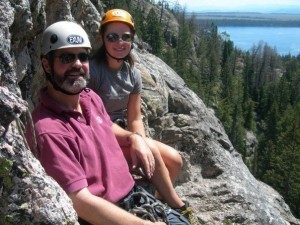
My Father and I attended Exum Climbing Camp
Climbing runs in my family. Besides my grandfather’s expedition with his sons, my father has climbed on three continents and took my older brother climbing in Chamonix Mont-Blanc when he was 14. On that particular trip to France, my mother and I (8 at the time) tackled a different mountain- Thunder Mountain, at Disneyland Paris.
When the summer of my 16th birthday approached, it was no surprise when my mother and father decided to meet me in Wyoming after I completed an Outward Bound course in Utah. It was finally my turn to summit a mountain alongside my father.
When we arrived in Wyoming in July, the summer climbing season was in full swing. Bearded, flannel wearing (yes, in July) muscle men roamed the climbing gear shops in Jackson Hole. Training camps were full, and we fortunately had reserved two spots and a guide through Exum Mountain Guides in Moose, WY.
Over two days, we reviewed top roping and avalanche drills; we tied countless knots and fitted all of our gear. Perhaps the most fascinating part of our training was that snow and ice climbing was no longer part of the regimen- back in 1972 there had been a glacier that had covered part of The Grand. Now, that glacier is all but gone.
On the third day, we began or ascent. We camped in the saddle, or low point, between The Grand Teton and its neighbor Middle Teton. We arrived, pitched our tents, and promptly crawled inside to ride out a 20-minute hail and lightning storm that had descended on the mountains. Hail the size of dimes pelted our cover as we tried to find rest on the rocky ground.
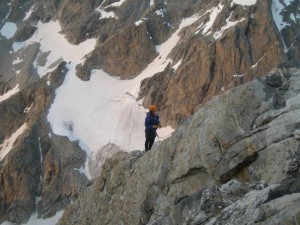
Approaching The Grand Teton summit as the sun rises
No sooner had we fallen asleep then our 3 a.m. alarms went off. It was time to make the final push. In the dark, we climbed with hands and feet up the rock scree just above the saddle. As we moved up further and further, the sun rose with us, bathing the towering rock spiral of the peak in an orange and pink glow.
We reached the summit just after sunrise. I stood there next to my father at the top of the same mountain he had climbed 36 years before with his own father, taking in the miles of Wyoming views. We looked down at the survey marker disk, hammered into the stone below our feet. “Huh, that’s interesting,” he said, “This survey marker says 13,770 feet. When I climbed it last, it was 13,766!” Through my altitude-induced exhaustion, I squinted up at him, “I guess we’ll just have to do another one to be even,” I sighed. He sat down next to me to take in the view. “Guess so…”
The post Wyoming: The Mountain That Runs In My Veins appeared first on We Said Go Travel.
May 9, 2014
Tripe Soup from Turkey
My husband and I were wondering through the Beyoğlu district of Istanbul, a few streets from the now infamous Taksim Sqaure. The multi-colored flags strung diagonally across the intersections and alleys waved calmly with the Bosphurous breeze. We came to this part of town on a tip from a friend. We were hunting for street food.
We started with Simit, a bagel-like round of crispy bread topped with sesame. I had mine plain, while my husband had his stuffed with sheep cheese and tomato. These can be sold two ways, soft or chewy to a crisp. I prefer the softer round. The bitter dough and the crunch of the sesame seeds that always get caught in my teeth are truly addictive.
Rows and rows of lemons caught my eye next. There were stacks of perfectly oval muscle shells nestled inside of the lemon rows. Midye dolma, street food style muscles, are served steamed and stuffed with spiced rice and lemon. We stood at the high top table near the cart and kept nodding at the man preparing the muscles in a “keep em’ coming” kind of way. The muscles were sweet and had a fresh thickness to them. The rice had been browned with spices, something like red pepper, thyme, and paprika. We ate about a dozen and ambled onto out next stop.
My sweet tooth kicked in right as the coffee was being poured. A long stretch of thick black brew, no sugar because it was for my husband. However, the tempting frosty square served on the plate with the coffee was all mine. Türk lokumu, or Turkish delight, are soft gelled squares flavored with fruits, flowers and nuts. This one was particularly indulgent with rose water and pistachio. I grabbed a few pieces to go, wrapped in pastry paper, and headed on with the sweetest morsel of candy still lingering in my mouth.
The next food adventure was the most triumphant and trying snack of the trip. “This place is famous! Many people will come here when the bars close” was the advice. What is it famous for? Tripe soup, işkembe çorbası, is a famed Turkish hang-over cure. We took a sharp left down a side street into the small opening of the café. There were four tables, an odd number of chairs, and a few TV’s playing live soccer. Two men sat, hovering over their bowls, in the corner by the window. Before we could sit down, a man with a stained white coat waved us to the back of the shop. His smile seemed to say that he was truly enjoying himself. We hesitated but followed his waving arms.
As our eyes rounded the corner, I realized that he wanted to show us the “behind the scenes” of his small restaurant. There was one large cutting board with minced pieces of grey and pink meat and a large vat built into the counter. The smell was overwhelming; at first it was pungent, like a cheese shop. But, as I stood there longer, it turned more sour and acidic. He grabbed a giant pair of tongs and dipped and swirled the soup in the vat, searching, stirring, searching. All of a sudden, the tongs pulled up the whole, giant, simmering stomach. My eyes widened into saucers, I was nervous.
Two bowls sat in front of us. We were face to face, trembling, having a showdown with the thickening yellow soup. A bowl full of bowels, if you will. Turkish food had not failed me yet, I was up for the adventure. How many times would I be sitting here? How many times do you get such a warm welcome from the cook yourself? How many times do you get to truly eat what the locals eat? We dug in. The texture was lovely, silky, reminiscent of lentil soup. But the smell was ripened, I couldn’t get past the achingly sour aftertaste. We tried and tried to add garlic and hot sauce, to finish a bowl, to be humble travelers. Even though our bowls were not empty, the risk was worth the reward of such a vivid memory.
After we politely put our spoons down and handed over the cash, I was ready for a cab back to our room. In the back of the cab, my stomach was still churning. My husband was laughing at my colorless cheeks. I didn’t want our snack-filled night to end like this. Until I smiled and remembered the handful of türk lokumu still safely tucked away in my pocket.
About the Author: Natalie Cowart earned her BA in Creative Writing from the Florida State University. She currently writes and teaches in Charlotte, North Carolina.
Thank you for reading and commenting. Please enter our next Travel Writing competition and tell your story.
The post Tripe Soup from Turkey appeared first on We Said Go Travel.
Bhutan: Nuns Secrets to Life
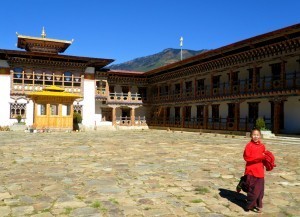 “Om Mani Padme Hum, Om Mani Padme Hum . . . (Hail to the lotus one!).” For several months, every morning I blissfully woke up to the repeating hums passing outside my window; the beloved morning routine of a vibrant seventy-seven year old Buddhist nun circumambulating the nunnery with a prayer bead in her left hand and a spinning prayer wheel in her right, emanating waves of blessings for all sentient beings.
“Om Mani Padme Hum, Om Mani Padme Hum . . . (Hail to the lotus one!).” For several months, every morning I blissfully woke up to the repeating hums passing outside my window; the beloved morning routine of a vibrant seventy-seven year old Buddhist nun circumambulating the nunnery with a prayer bead in her left hand and a spinning prayer wheel in her right, emanating waves of blessings for all sentient beings.
I would watch her passionately pray on by until her rich pomegranate robe flashed out of sight around a corner for another round along the most spectacular monastery in the world, The Pema Choling Nunnery, which is virtually unknown to the outside fast paced world. It’s hidden deep in the folds of the Himalayan Mountains perched on a flat mountaintop in the last tantric Buddhist Kingdom on earth; Bhutan!
The mystical nunnery can be reached by a jagged, dirt road. The long, bumpy ascent is worth the panoramic views of colossal mountains after mountains covered in pine trees that sparsely open up to scattered villages and variegated fields. The nunnery itself is equally breathtaking: A two story classical, white washed monastery with ornate edges and built by the loving hands of the nuns themselves.
Infused with love, the nunnery radiates tingling energy while walking through its motif-framed doorways leading to a beautiful stoned slab courtyard. The first time I entered it under an open sky and barricaded by mountain peaks, I became under a magical love spell as I did several slow 360 degree turns taking in its beauty: An array of colorful potted flowers outlining the perimeter, a glowing temple with hundreds of sparkling butter lamps, the smell of sweet incense drifting under doorways… Out of the dozens upon dozens of monasteries I had visited over the year, it was the most awe-provoking monastery of them all!
I was in heaven to be able to call this my new home when I became the monastery’s first foreign English teacher. However, I also came to be the nuns student; not necessarily a student studying Buddhism, but a student learning about the simplicity of life – something that’s not taught in the curriculum of Western schools; something that may be learned through deep reflection of life experiences or in my case, from living on a remote, peaceful mountain with over a hundred nuns ranging from age 6 to 77.
My first life lesson I learned at this magical place was easy to grasp as it smacked me in the face from the moment I arrived when plans seemed to always change. For instance, one minute there was class, but the next minute it was cancelled for a puja (ceremony); one minute there was a trip to the market, but the next minute it was on hold for collecting firewood. Unlike most Westerners, the nuns never seemed to be in a hurry, as though there was no such thing as time. They weren’t attached to schedules; as a result, they didn’t suffer when things abruptly changed. Slowly I learned to be like the nuns and accepted that “things are always changing,” which became my new motto. And weeks later, I added a second half to my motto that was the true gem of it: “… so go with the flow.”
However, my favorite and most valuable lesson came from admiring the pure sweetness of the nuns golden hearts. They demonstrated gentleness to every living creature, including the ones most people consider varmint: Mangy stray dogs, dirty rats, thirsty mosquitoes… I had never met people who were as compassionate as the nuns, as they educated me about the cause and effect of karma – ones accumulated merits from good and bad deeds resurfacing as positive or negative events in ones life.
They showed me how to gently remove an insect from my room without harming it, and they even urged me not to let my adopted, stray cat kill rats on sacred full moon nights in order to help my cat create less bad karma. I half laughed inside thinking about how my Western friends would have thought that these traditional bald nuns were insane, but the other half of me didn’t dare chuckle because I knew that they were the wisest group of women on earth. The nuns knew a simple secret to life, yet more importantly they practiced it wholeheartedly: Love every single organism, big or small, without discrimination!
The nuns became my greatest teachers showing me numerous simple secrets to a peaceful life that were in plain sight. The stunning nunnery hidden by the great Himalayas of Bhutan was more than my home, it was a mystical place that taught me to go with the flow of impermanence and love all creatures.
About the Author: Sabrina Soares from California is an elementary teacher who loves adventures. She is currently self-publishing a book about fear, love and change based on her year long experience teaching in Bhutan, which was inspired by many requests from her blog.
Thank you for reading and commenting. Please enter our next Travel Writing competition and tell your story.
The post Bhutan: Nuns Secrets to Life appeared first on We Said Go Travel.
Espírito Santo, Brazil: How I almost got arrested for stealing my own bag
I got off the bus in a small town in the state of Espírito Santo, Brazil, where I would change over to another bus on my way to Itaúnas for a famous forró festival. It was late at night, the skies were dark and the small dingy streets illuminated by artificial lights. I was 6 hours from Vitoria and had just spent those hours stuck next to a man with his never-ending packet of ruffles. Safe to say I was exhausted and agitated. I stood in line, waiting patiently to collect my bag from under the bus in order to transfer it to the next bus that would bring me to my destination, and according to some chit chat on the bus, the last bus would leave at 10.30pm (or in other words approximately 15 minutes).
My portuguese skills having only spent the one week in Brazil were poor, and that was being generous, so in line I waited as the man asked people the same repeated question before letting them take their bag. As the bus emptied and as I approached the bag compartment I realised that every passenger was handing the driver a little white slip in order to collect their bags. I checked my wallet, my passport and every pocket in between, but mine wasn’t to be found.
That ticket, that stupid insignificant piece of flail white paper that I was handed 6 hours ago when I originally dropped off my bag was nowhere. It was gone; probably still sitting on my seat on the bus, among the ‘rubbish’ I left on board. I waited until I was last in the line until my bag was the only one left. I thought it would be that easy.
I tried to speak in broken portuguese the best I could – “Desculpe” (Sorry) “Eu não tenho” (I don’t have) .
He just looked at me, vacantly, and his actions didn’t need words. The shrug of his shoulders and the raise of the eyebrows said it all. “Too bad.”
“Por favor, aquele é meu mochilão!!” (Please, that is my backpack!)
I showed him my back which had a matching smaller version of the backpack. No expression except that of his eyes rolling in the opposite direction. He playing a game, teasing me as if he had had the worst day in the world and wanted to pass on the displeasure.
Desperately, I stared at my bag, and noticed that I still had an airline ticket attached to it. I grabbed out my wallet and showed him my identification, to compare with the airline tag. But it was so use: No ticket, no bag.
He was playing some sort of serious game here, either that or he was just blatantly being an a#$hole. At this point I was the only one left, and this was the only bag. He knew it was my bag, the matching backpacks told him so. He knew it was my bag, because my name was clearly written upon it. He gave me a look, and I could see the twinkle in his eye, basically telling me, he’s going to screw with me tonight. He wasn’t not going to stop with this stupid game.
He started to pull the latched door shut to seal off the compartment containing my single backpack. In an act of desperation, I reached out and grabbed my bag before quickly running away. He chased me, yelling words that I didn’t understand. I kept running, trying desperately to lose him so that I could make my way to the next town. As I ran with the weight of my backpack upon on back, my foot gave way and my ankle collapsed hard and fast into a pothole. There I was, captured, as if he had purposely laid out a booby-trap.
There was no escaping. As I attempted to stand up and pull up both my own weight and the weight of my turtle shell, he had managed to catch up to me. I wiped my leg of the blood and rocks and ignored the pain over his loud overbearing taunts in Portuguese. He was singling me out with evident words of attack. I could only imagine what it would have looked like to onlookers- an overweight 60+ year old Brazilian man yelling at a young foreign girl. I called out desperately to an on-looking local, “Descuple, onde fica onibus para Itaúnas?” (Where is the bus for Itaúnas?) He called out the directions and with them I stumbled away, slowly, but away. The bus driver followed me, at a distance but at the same pace, and I did my best to block out all sounds of taunt and criticism.
The yelling stopped after a couple of minutes, but within only a minute more I started hearing the calls of someone behind me again.
‘Oi, Oi!!’
Screw this, I thought, what on earth is this guys problem? I walked faster. I continued to hear footsteps, harder and faster, nearing closer and closer, ‘Oi, oi! Onibus não esta la, onibus esta aqui!” (You’ve gone past the busstop!) I turned around to see the man who gave me directions chasing after me, because in my frustration and anger, I had walked straight past the stop. I turned around, and started to head back towards him, desperately thanking him for looking out for me.
I found an empty spot on the ground, put my backpack down and sat upon it, waiting. He sat down as well, maybe 2 meters away from where I was sitting. I knew he was only sitting there to look out for me, even though he didn’t utter another word. I am forever grateful to this man- because without him, the next 5 minutes would have been much harder to handle.
The man was back, his face sterner than ever. He walked up and came right up into my face, the saliva from his words spraying across my face. I had no idea what he was saying, but I didn’t like the energy, I didn’t like the attitude, I didn’t like him. Every phrase, every word, every single swear word that I know in Portuguese all blurted out like word vomit, straight back at him. Then he grabbed the strap of my bag and I desperately ripped it back from his grasp, “DON’T F*ING TOUCH ME,” in straight English. I didn’t care if he didn’t understand the words, he would know what I meant. The scream that came from me attracted a lot of attention. Suddenly there were people running up to me, speaking in Portuguese to the man as I stood there, feeling completely violated.
I stood there, shaking, frustrated, fuming as the tears streamed down my infuriated face, watching the conversations unfold, understanding only the hand gestures that were being made. Then the man pulls out his phone and starts dialing, and I hear the word ‘policia’. I didn’t say a word, I just stood back and tried to calm myself down. A loving hand was put on my shoulder and with that I was handed a bottle of water. The kindest around me at this point well and truly outweighed the one outsider. I couldn’t be thankful enough.
The police turned up, as if they were on standby in the area. I didn’t want to talk to them and I didn’t want to look at the man. At that point and time I would have loved to have just curled up into a ball with my headphones in my ears and blast some really loud music. I didn’t though. The man gestures towards me, pointing, agitatedly speaking to the police. I had no idea what would happen next. They asked for my passport, and I reluctantly showed them. The policeman wrote down my details just as the bus pulled up. I looked back and forth, from him to the bus, and with just one discreet wink from the policeman I knew I would be boarding that bus. They took the angry busdriver away with very little force to calm him down, and there I was, free and without a conviction, and only an hour or so any from my next destination.
The post Espírito Santo, Brazil: How I almost got arrested for stealing my own bag appeared first on We Said Go Travel.
We Said Go Travel
We Said Go Travel is a global community of over sixteen hundred writers with articles from every continent.
Stories are shared with photos and video from a perspective of the transformative power of travel. We Said Go Travel has hosted live and online events as well as travel writing contests around the world. ...more
- Lisa Niver's profile
- 57 followers


